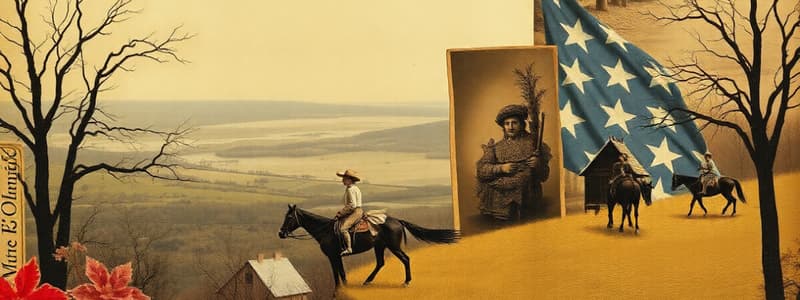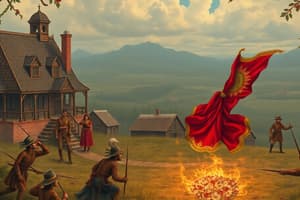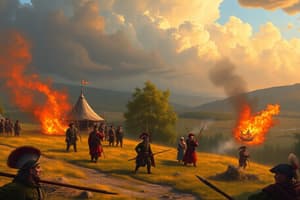Podcast
Questions and Answers
Considering the strategic objectives of both the British and the French, which geographical feature was most critical in determining control over North America?
Considering the strategic objectives of both the British and the French, which geographical feature was most critical in determining control over North America?
- The Mississippi River, offering a crucial transportation route connecting New France and Louisiana.
- The Atlantic Coast, providing Britain with naval dominance and control over trade routes to Europe.
- The Ohio Valley, representing a vital link between French territories and offering potential for British trade and growth. (correct)
- The Appalachian Mountains, as they provided a natural barrier against colonial expansion.
If the Albany Plan of Union had been adopted, which of the following outcomes would have been least likely in the lead-up to the Revolutionary War?
If the Albany Plan of Union had been adopted, which of the following outcomes would have been least likely in the lead-up to the Revolutionary War?
- Reduced tensions between colonies, fostering a sense of shared identity and purpose.
- A centralized colonial government capable of negotiating treaties and regulating trade more effectively.
- Increased colonial unity and a more coordinated defense strategy against the French.
- Greater colonial acceptance of British governance due to increased representation and influence. (correct)
How did the British military tactics during the early stages of the French and Indian War contribute to their initial defeats?
How did the British military tactics during the early stages of the French and Indian War contribute to their initial defeats?
- The British relied heavily on naval blockades, which proved ineffective against French inland fortifications.
- The British focused on capturing major cities, neglecting the importance of controlling key strategic locations in the wilderness.
- The British overestimated the strength and preparedness of the colonial militias, leading to inadequate troop deployment.
- The British employed open-field warfare strategies unsuited to the dense forests and guerilla tactics used by the French and their Native American allies. (correct)
Considering the long-term consequences, how did the Treaty of Paris (1763) indirectly contribute to the American Revolution?
Considering the long-term consequences, how did the Treaty of Paris (1763) indirectly contribute to the American Revolution?
How did the Proclamation of 1763 attempt to resolve tensions between colonists and Native American tribes, and why did it ultimately fail to achieve its objective?
How did the Proclamation of 1763 attempt to resolve tensions between colonists and Native American tribes, and why did it ultimately fail to achieve its objective?
What was the primary economic rationale behind the Sugar Act, and why did it generate significant opposition from the colonists?
What was the primary economic rationale behind the Sugar Act, and why did it generate significant opposition from the colonists?
How did the Committees of Correspondence facilitate colonial resistance to British policies, and what were their limitations?
How did the Committees of Correspondence facilitate colonial resistance to British policies, and what were their limitations?
In what ways did the Daughters of Liberty contribute to the colonial resistance movement, and how did their actions challenge traditional gender roles of the time?
In what ways did the Daughters of Liberty contribute to the colonial resistance movement, and how did their actions challenge traditional gender roles of the time?
Considering the perspectives of both the colonists and the British soldiers, what factors contributed to the escalating tensions that culminated in the Boston Massacre?
Considering the perspectives of both the colonists and the British soldiers, what factors contributed to the escalating tensions that culminated in the Boston Massacre?
How did Paul Revere's depiction of the Boston Massacre influence public opinion, and what criticisms can be made about its accuracy and objectivity?
How did Paul Revere's depiction of the Boston Massacre influence public opinion, and what criticisms can be made about its accuracy and objectivity?
Flashcards
The Ohio Valley
The Ohio Valley
A region claimed by both Britain and France, stretching along the Ohio River.
Alliance
Alliance
A formal agreement among groups or individuals.
Parliament
Parliament
The lawmaking branch of the British government.
Treaty of Paris
Treaty of Paris
Signup and view all the flashcards
Proclamation of 1763
Proclamation of 1763
Signup and view all the flashcards
Budget
Budget
Signup and view all the flashcards
Stamp Act
Stamp Act
Signup and view all the flashcards
Congress
Congress
Signup and view all the flashcards
Boycott
Boycott
Signup and view all the flashcards
Repeal
Repeal
Signup and view all the flashcards
Study Notes
- Spain, France, and Britain sought to control land in North America.
- Spain's claims were mainly in the southwest and Florida.
- France claimed lands north and in the middle of what is now the United States.
- Britain's claimed land was mainly along the Atlantic coast.
The Ohio Valley
- Both Britain and France claimed the Ohio Valley, stretching along the Ohio River from the Appalachians to the Mississippi River.
- Britain viewed the Ohio Valley as an area for trade and growth.
- France considered it a connector between New France and Louisiana.
- By 1750, France sent soldiers to drive out the British and built forts near the valley's eastern end.
- Britain viewed this as an act of war and decided to fight back.
The French and Indian War Begins
- The war began in North America in 1754 before spreading to Europe.
- Native Americans fought on both sides but mainly for the French.
- By the mid-1700s, both France and Britain allied with Native American tribes in the Ohio Valley.
- An alliance is a formal agreement between groups or individuals.
- The French and British asked their allies for help.
- In June 1754, colonial leaders met in Albany, New York, including Benjamin Franklin.
- They met to discuss how to deal with French forces, with seven colonies sending delegates.
- Franklin proposed that the colonies unite to fight the French by way of the Albany Plan of Union.
- This plan wasn't approved because the colonies weren't ready to fight as one country.
- A month earlier, the British governor of Virginia sent 150 soldiers led by 21-year-old George Washington to take the Ohio Valley from the French.
- The Virginians fought French soldiers and built Fort Necessity.
- On July 3, 1754, the French and their Native American allies attacked, and the Virginians surrendered due to being outnumbered
- This battle marked the beginning of the French and Indian War.
The War Expands
- The Colonists knew they needed help to win the war
- The British Parliament sent an army to aid in the fight against the French and Native Americans
- General Edward Braddock led the British
- In April 1755, Braddock and 1,800 troops attacked the French at Fort Duquesne, with George Washington as an adviser.
- Washington noted the British soldiers in bright uniforms marching through the forest.
- The British were trained to fight in open fields
- The French fought like their Native American allies from behind trees.
- This made the British easy targets and led to early British defeats.
- Braddock was killed in battle
- Early battles went poorly for the British.
- Britain sent more troops and supplies, shifting the war in their favor.
- British soldiers captured Fort Duquesne, French forts, Quebec, and Montreal.
- In 1756, France and Britain began fighting in Europe, drawing in Spain on France's side and a stronger British navy defeated the Spanish in 1762.
- To compensate Spain for it's losses, France ceded most of Louisiana.
The Treaty of Paris
- The French and Indian War ended in 1763.
- The Treaty of Paris gave Britain most of Canada, French lands east of the Mississippi River, and Spanish Florida
- France lost almost all its North American lands.
More Troubles
- The end of the French and Indian War did not end Britain's troubles in its colonies.
- Colonists wanted to settle lands between the Appalachian Mountains and the Mississippi River, which was now under British control.
- These lands were home to many Native American groups who wanted to keep them out.
- In 1763, Ottawa chief Pontiac united groups along the Mississippi River and captured some British forts.
- Native Americans also attacked colonists' settlements near those forts.
The Proclamation of 1763
- King George III tried to end the fighting by issuing the Proclamation of 1763.
- It declared that lands west of the Appalachian Mountains belonged to Native Americans.
- White settlers in those lands were ordered to leave.
- Colonists largely ignored the Proclamation, believing they had fought for the right to settle the western frontier.
- Additionally, they resented the British government telling them to stay out of those lands.
- As a result, fighting between Native Americans and settlers continued.
Paying for the War
- Colonists grew angry about new taxes passed by Parliament after the war.
- British leaders, examining their budget, decided the colonists should help pay off the cost of the war.
- In 1764, Parliament passed the Sugar Act, taxing sugar and molasses from the West Indies.
- The Sugar Act mainly hurt New England Colonies shipping businesses.
- Many merchants objected to the tax, but British government kept taxing sugar and would soon pass even more taxes.
The Stamp Act
- In 1765, Parliament approved the Stamp Act placing a tax on paper items in the colonies and requiring a special stamp to show it had been paid.
- British leaders argued the tax was fair.
- Many colonists were angry because they had no representation in Parliament and had no say.
- Massachusetts writer Mercy Otis Warren disagreed writing plays that accused British leaders of being greedy.
- Virginian Patrick Henry said Parliament did not represent the colonies.
- Supporters of Parliament shouted “Treason! Treason!" accusing Henry of working against the government.
- In October 1765, representatives from nine colonies met in New York City as the Stamp Act Congress.
- Colonial leaders spoke out against the Stamp Act, leading to the slogan “no taxation without representation".
Colonists Work Together
- The colonists tried to get Britain to take back the Stamp Act.
- Some wrote letters to Parliament.
- Other colonists chose not to buy taxed goods or began to boycott all British goods.
- Soon after the Stamp Act passed, colonists called the Sons of Liberty began to work against it.
- Liberty meant freedom to make their own laws.
- The Sons of Liberty captured British workers who tried to collect the tax, covering them with tar and feathers, and chased them out of town.
- Women supported the cause by forming a group known as the Daughters of Liberty.
- Members spun thread and wove their own cloth rather than buying British goods.
- The group's cloth-making was so popular that woman in Providence, Rhode Island chose the city courthouse as the meeting place.
- By 1776, so many colonists opposed the Stamp Act that Parliament voted to repeal the act.
- The next day, Parliament passed the Declaratory Act, asserting that Britain had the “full power... to make laws… [for the] people of America… in all cases".
- This new law alarmed many colonists.
Committees of Correspondence
- The repeal of the Stamp Act showed the colonists that they could work together, but needed better ways to share information.
- News traveled slowly since letters were delivered by riders on horseback.
- To spread information between colonies more quickly, the colonists formed Committees of Correspondence.
- Committee members wrote letters to each other.
- The letters told what was happening in each town and colony.
- Samuel Adams started the first Committee of Correspondence in Boston in 1764 and had spoken out against British imperial policies, the laws issued by the king and the British Parliament.
- The next year, colonists in New York formed another committee.
- Colonists soon spoke of the need for Committee of Correspondence in every colony.
- Virginia formed a committee in 1773 where members wrote that all colonists should be "much disturbed by various rumors and reports of proceedings tending to deprive them of their ... rights."
- Committee members encouraged colonies to start Committees of Correspondence.
- Members in each colony wrote to other cities and towns, asking people in other colonies to protest or work against British policies.
Supporting The Boycott
- To support the boycott against British goods, sewing groups sprang up all over the colonies.
- Girls did most of the spinning, weaving, and sewing.
- Twelve-year-old Anna Green was part of a sewing group at her church in Boston.
- Fifteen-year-old Charity Clark spun wool in her home in New York City.
The Townshend Acts
- In 1767, Parliament passed the Townshend Acts that taxed imports, such as glass, tea, paint, and paper.
- The acts set up new tax collectors.
- Parliament thought it still had the right to make laws for the colonists even after repealing the Stamp Act.
- Colonists boycotted British goods.
- The Daughters of Liberty asked people to stop drinking British tea, and merchants in Boston would not import taxed goods.
- Because some colonists would not want to pay a tax on paint some would not paint their houses.
- Like the Stamp Act, the Townshend Acts did not last long because sales of British goods in the colonies went down and tax officers collected little money.
- In 1770, Parliament repealed all the Townshend Acts except for the tax on tea.
- Many colonists still would not buy British tea, and as the number of protesters grew, Parliament sent more soldiers to the colonies and stationed 4,000 of them in Boston in 1770.
The Boston Massacre
- Having British soldiers in the towns angered colonists.
- The colonists made fun of the soldiers' bright red uniform jackets, calling them "lobsters" and "redcoats."
- Some angered soldiers destroyed colonial property.
- Fights broke out between colonists and British soldiers.
- On March 5, 1770, a large crowd of angry colonists gathered near several British soldiers in Boston.
- The colonists shouted at the soldiers and threw rocks and snowballs.
- After some of the crowd knocked down the soldiers, they opened fire.
- Three colonists were killed on the spot, and two others died later.
- Among the dead was Crispus Attucks, an African American sailor.
- Many people think of Crispus Attucks as the first person killed in the fight for the colonies' freedom.
- Paul Revere, a Boston silversmith, supported the colonists and made a picture of the shooting.
- Paul Revere titled his piece The Bloody Massacre.
- The killing of many people who can't defend themselves is called a massacre.
- The shooting became known as the Boston Massacre.
Studying That Suits You
Use AI to generate personalized quizzes and flashcards to suit your learning preferences.




